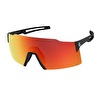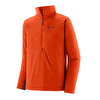Variant of Li-Cuore up the NE Face of Monte Agner, a mountaineering story

 1 / 15
1 / 15 archivio Luca Vallata / Tito Arosio
archivio Luca Vallata / Tito Arosio
Alpinists are a strange folk. Take this description for instance: "Our route isn't beautiful, isn't healthy, cannot be recommended, breaches five aid pitches up very loose rock for which we used three fixed ropes..." The route is called Variante del Li-Cuore. And those who asked us whether we might be interested in publishing something about it were the two first ascentionists, Tito Arosio and Luca Vallata. Bearing the above in mind, a "normal" person, someone who knows better or who perhaps knows little about alpinism in general would reply with a kind "no thank you". But as we said, alpinists are a strange folk. You can rest assured that they want to find out more, especially if the premise if followed by a but, by the fact that it's all true, yes, it's a terrible route but also... "a journey into an enormous rock face". And so it turns out that the face they climbed is the famous 1200m high, immense and wild NE Face of Mount Agner in the Dolomites. And the variation they've established weaves a 450m unexplored line between two historic, legendary Dolomite routes. Namely the South Tyrolean climb, put up by Reinhold Messner, his brother Günther Messner and Heini Holzer in 1967, and Via del Cuore, established by the great Lorenzo "Mass" Massarotto and Sandro Soppelsa in 1981. We also discovered that this climb came about thanks to grandfather who told his grandson about the climbs of Riccardo Bee, another great alpinist who left an indelible mark on these, and other, mountains. And there's that yellow corner, overhanging and full of loose rock, climbed by Vallata and Arosio right in the centre of the heart of the NE Face. And of course there are the photos, of a distant and remote place which the two reached to establish their "not beautiful, not healthy and not recommended" variation. In the end we became convinced that this is a route we're never going to climb. As convinced that theirs is a story about mountaineering that absolutely deserves to be published.
MONTE AGNER - NORTH EAST FACE VARIANTE DEL LI-CUORE by Tito Arosio
Agner, north face: Luca wants to climb the obvious yellow corner to the left of the South Tyrolean route and to the right of way of Via del Cuore.
The idea fascinated me right from the outset, up there we'd certainly face difficulties connected to both the climbing and the ambient, it being one of the most remote in the Dolomites. From the Cozzolino bivouac you need to scramble up the 700m pedestal to reach the base of the face and although it faces NE, it always remains in the shade because the sun remains hidden behind Spiz Sud d’Agner.
Luca and I entered the heart of the Agner NE Face four times. Four times we scrambled up the pedestal with heavy packs to attempt our route and despite this effort, we were always super motivated to reach that yellow corner, lost up there in the immenseness of this north face.
Our first attempt was decidedly optimistic, we thought the corner would go free, but we only reached it after 3 new slab pitches; the climbing up these was fantastic, excellent tock, first grey then yellow, ideal for free climbing.
When we entered the corner though things changed abruptly, we immediately realised that things wouldn't be easy, that we'd have to forget free climbing it due to the chossy rock and black streaks that ran down the crack at the base of the corner.
Another four days of "work" split into two attempts to complete the corner and traverse below the roofs that turned out to be somewhat easier than we had feared. We did some pretty dodgy aid climbing, up pegs that didn't "sing", cliff hooks and friends wedged into decidedly chossy cracks. Despite these difficulties we managed to establish some excellent belays; none of us are expert aid climbers so the grades we've given need to be taken with a pinch of salt.
Inside the large yellow corner, from where one can see the legendary corner of the Bellunese route, our thoughts wandered to Bee and Miotto; and it was from Bee that Luca had drawn inspiration for this unfashionable climb.
A final attempt before the start of autumn saw us jumaring up the fixed ropes we'd previously left in the corner and there were some moments of panic as the ropes ran across some sharp rock. Above the yellow corner the grey slabs proved less difficult than we had originally thought; the rock is the exact opposite of that on the corner below, it's excellent, weathered and offers a series of threads. Two grade V pitches and one grade VII - the latter climbed more with might than with intelligence - led us to the slabs to the left of the South Tyrolean route and where some variations connect this route with Via del Cuore.
The mid-September cold, the face sprinkled with snow and verglass, made us opt for a quick exit up the Cuore route, the Head Wall lies in wait for another team. After so many days spent in the shadow on the North Face, on Sunday 22 September at 17:00 we finally reached the sun and summit, immensely happy!
RICCARDO BEE by Luca Vallata
It was my grandfather who first told me about Riccardo Bee, they'd worked together at Itis in Belluno when I was very young and he told me these stories that, through his and my mountaineering ignorance, became sort of legendary. He once told me that someone had stolen Bee's bivy gear from his rucksack and, when darkness fell, he was forced to walk back and forth on a ledge all night, know one knows when or where though.
So just like many had Messner or Bonatti as examples to look up to, I had Richard Bee. The only thing I had of him was a blurred picture thanks to the overexposed photos taken during the winter ascent of Burel or by the accounts of his friends and acquaintances, the traces he left scattered here and there on many people in our area.
I'd also spoken about Riccardo with Franco Miotto, not bitter at the time and Bee's great climbing partner. I watched a wonderful slide show and recognised him once again during a protest march against Gelmini while at high school. Franco was part of the ANPI delegation of proudly wore the club flag while I, all excited, introduced myself and we chatted for a while.
My grandfather continued to talk to me about Riccardo as I grew older and started to climb, but the tone and intention behind the stories changed somewhat "Watch out, he was one of the best, but nevertheless he fell." It's no secret, Riccardo died on the North Face on Agner in 1982, around Christmas day and if I write with such intimacy, even if I was born 8 years after that freezing day, it's because Bee has always played an important role in my own mountaineering.
What was it like to be alone in that colossal, snow-plastered face?
The first time I climbed up Agner's North Face was together with my friend Diego, we wanted to repeat Via del Cuore established by powerful Mass (Lorenzo Massarotto ed) but when we reached the top of the pedestal we realised the climb was soaking, unclimbable. So we traversed across the entire face and joined up with the Messner route and, without a topo, we followed our instinct upwards. At the ledge we noticed that the final streak was still wet and so.... another traverse back to join up with Via del Cuore... That ascent allowed us to study from all angles the Direct Bee route, the variation that Riccardo added to the South Tyrolean route. So where did he climb? The central drip looked dirty and horrid, perhaps he chose the corners to the right? Or perhaps the yellow section to the left of the waterfall?
Many things impressed me that day but I was struck in particular by a large yellow corner that cut right through the centre of what Mass had described as the Heart of Agner. It rose upwards, immediately to the left of the Direttissima, and that's where the idea came from for our route. Our route isn't beautiful, isn't healthy, cannot be recommended, breaches five aid pitches up very loose rock for which we used three fixed ropes, but it's a journey into an enormous rock face, the line is logical and at a certain point there's a traverse left beneath the large roofs from where retreat is almost impossible. Up here you experience the face and adventure that Bee sought while climbing in such an annoyingly anachronistic manner, with aiders and Tepa Sport shoes while Manolo was already climbing 8a.
The style of ascent is akin to that of Riccardo, the man who felt completely at home on the big mountain faces and tiny bivouacs.
by Luca Vallata
Practical information to repeat Variante Li-Cuore
1200m rock face, of which circa 450m are new.
In the large corner all belays are practically equipped with in-situ gear, with large nuts and some wooden pegs.
Most pegs we used are still in-situ, in total 35 pegs.
For a repeat take
- two sets of Camalot, triple sizes 0.75, 0.5, 1, 2 and 3, and one 4.
- nuts of all sizes
- a dozen pegs, both long and short, plus some extra short ones
- aiders
- a chair for the belays
Check out the route topo



 Copia link
Copia link













 See all photos
See all photos






















